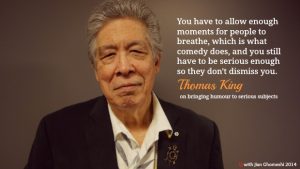Write a blog that hyper-links your research on the characters in GGRW for pages 85 to 96. Be sure to make use of Jane Flick’s reference guide on you reading list.
Alberta
At the beginning of this section, Alberta compares marriage to being on a plane. In this analogy, the husband is the pilot. It is understandable that Alberta is against marriage if she believes it to follow the rule that the husband is the leader and is in charge. Alberta can be characterized as independent, as she wants to raise a child on her own, and giving the reigns of her life over to man seems to be an undesirable idea. Which would explain why her short marriage with Bob didn’t work out.
“They all demanded something, insisted on privileges, special favours” (King, 90).
Bob
Alberta describes Bob as “handsome and witty” (King, 86). What he turns out to be after getting married is controlling and selfish. It is not hinted at in the short text about Alberta and Bob’s time dating, however, it can be speculated that there were warning signs of this type of behavior from Bob that Alberta wouldn’t have picked up on because she grew up in a home with a dysfunctional marriage.
Amos (Alberta’s Father)
Amos is an alcoholic. Ironic as the name ‘Amos’ is a Hebrew name meaning ‘strong’. Alberta reminisces about the last time she saw her father come home. He was drunk, a complete mess, and crashed his car into the outhouse. As kids, Alberta and her siblings had a hard time watching and wanted to help their father. Her mother, however, seemed tired of dealing with him.
Ada (Alberta’s Mother)
Amos’s car is left in a puddle where the outhouse used to be. Ada leaves the pickup in the water slowly rusting over the years and never speaks of the incident with Amos.
Babo
“There was just water” (King, 91) begins Babo telling the story of creation.The reader understands Babo’s story is not being told right because of hearing the beginning of the story of creation so many times. Babo jumps around while story telling and evades answering the questions asked of her. She has the information the Sergeant needs, however he treats her poorly and doesn’t get the information. As Flick points out, Babo’s character alludes to a black slave and barber from the story “Benito Cereno” in Piazza Tales by Herman Melville (Flick, 145).
Works Cited
“Baby Names.” Amos Name Meaning. N.p., n.d. Web. 15 July 2016.
Flick, Jane. “Reading Notes for Thomas King’s Green Grass Running Water.” Canadian
Literature 161-162. N.p., 1999. Web. 16 July 2016.
King, Thomas. Green Grass, Running Water. Boston: Houghton Mifflin, 1993. Print.




 I then read the story aloud to myself and to others. Something I immediately noticed once reading it aloud was the repetition. I found rather than adding clarity, the repetition confused me and most of the time had my listeners beginning to become bored of the story.
I then read the story aloud to myself and to others. Something I immediately noticed once reading it aloud was the repetition. I found rather than adding clarity, the repetition confused me and most of the time had my listeners beginning to become bored of the story.
